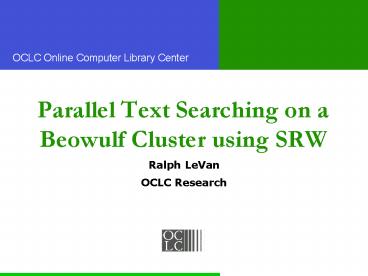Parallel Text Searching on a Beowulf Cluster using SRW - PowerPoint PPT Presentation
1 / 12
Title:
Parallel Text Searching on a Beowulf Cluster using SRW
Description:
Demonstrate 100 searches/second on our 50 million record WorldCat database ... Searched using OCLC Research's Open Source Gwen and Pears toolkits. Architecture ... – PowerPoint PPT presentation
Number of Views:47
Avg rating:3.0/5.0
Title: Parallel Text Searching on a Beowulf Cluster using SRW
1
Parallel Text Searching on a Beowulf Cluster
using SRW
- Ralph LeVan
- OCLC Research
2
Goal
- Demonstrate 100 searches/second on our 50 million
record WorldCat database residing on a small
Beowulf Cluster
3
Beowulf Cluster
- 24 nodes
- 2 2.8GHtz Xeon CPUs
- 4 GB of memory
- 80 GB of disk on 23 application nodes
- 130 GB of disk on root node
4
Database
- 50 million records
- 69 partitions (700,000 records)
- 3 partitions per application node
- Partitioned by popularity
- Searched using OCLC Researchs Open Source Gwen
and Pears toolkits
5
Architecture
- 1 Tomcat on each application node
- 3 SRW/U databases configured for each Tomcat
- 1 client application on the root node
6
Trial 1
- SRW client searching 69 databases
- Result
- 2 searches/second (437ms/search)
- Ganglia Cluster Report shows the root node
glowing red and the application nodes a peaceful
blue
7
Trial 2
- SRU client with scanned response searching 69
databases - Result
- 25 searches/second (40ms/search)
- Ganglia Cluster Report still shows the root node
glowing red and the application nodes a peaceful
blue
8
Trial 3
- SRW client with hand built XML and scanned
response searching 69 databases - Result
- 21 searches/second (46ms/search)
- Ganglia Cluster Report still shows the root node
glowing red and the application nodes a peaceful
blue - SRW dropped
9
Rearchitecture
- Problem Ganglia Reports indicate that the client
is the bottleneck - Solution Put a 3-way federator on each Tomcat (a
virtual database for the client) and have the
client search 23 databases instead of 69
10
Result
- SRU client 71 searches/second (14 ms)
- Hand-built SRW client 33 searches/second (30ms)
- Original SRW client 6 searches/second(164)
- Ganglia cluster report still shows root node red,
but application nodes are now green and yellow
11
Rearchitecture
- Create a virtual 23-way database on each Tomcat
that will federate searches from the 23 virtual
3-way databases - Put one of these on each Tomcat
- Create a new client that sends searches on
threads to each available 23-way database
12
Result
- With 23 threads, 172 searches/second
- Average response time of 170ms
- The Ganglia report showed all nodes running red































